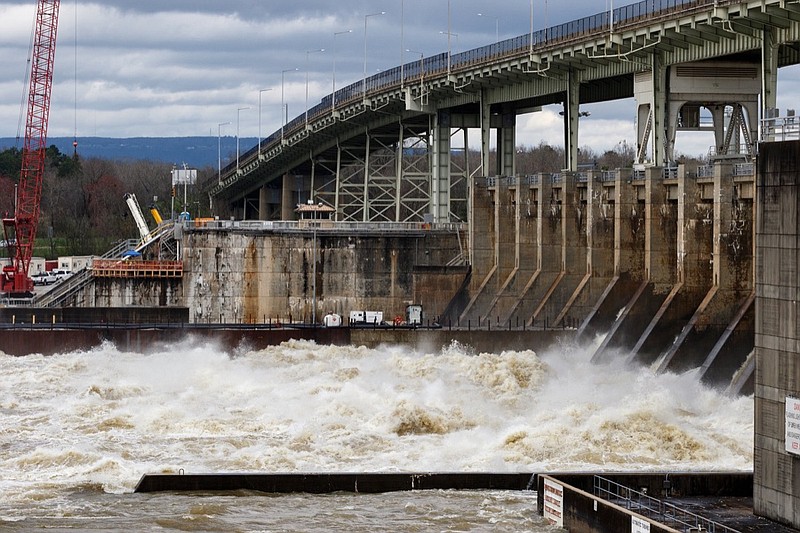Last year was the second wettest year on record in the Tennessee Valley, following record rainfall totals in 2018.
TVA said Thursday that total precipitation in the Tennessee River basin was nearly 15.5 inches above normal during 2019, and included the wettest February on record when the rain-swollen river in Chattanooga rose 12 feet above its normal levels.
Darrell Guinn, manager of TVA's River Forecast center in Knoxville, said 2020 is also starting out wetter than normal with 2-4 inches of rain expected to fall Thursday through Saturday across TVA's seven-state region.
Five-day forecast
FridayClouds, fog, rainHigh: 60 | Low: 47SaturdayBreezy, rain to light snowClouds, fog, rainHigh: 55 | Low: 29SundayClearing, seasonableClouds, fog, rainHigh: 52 | Low: 33MondaySunny, mildClouds, fog, rainHigh: 54 | Low: 40TuesdayShowers returnClouds, fog, rainHigh: 53 | Low: 33Source: WRCB-Channel 3 as of 5 p.m. Thursday
"Our forecasts call for wetter than normal weather in the next three months," Guinn said.
Chattanooga is under a flood watch, although no major flooding is expected this week.
TVA uses its network of 49 dams on the Tennessee River and its tributaries to help control the flow of the Tennessee River, the fifth biggest river in the United States. Last year, TVA estimates that its flood control efforts helped avert $1.8 billion of flood damages in the Tennessee Valley, including $1.6 billion in Chattanooga. That was the highest level of averted flood damages in the 87-year history of TVA.
Chattanooga is the drainage basin for rainfall across East Tennessee and parts of western Virginia, North Carolina and Northeast Georgia, and without TVA's dams, much of Chattanooga would have been under water in February.
"Chattanooga is a bottleneck and is the most susceptible to flooding in the region," Guinn said.
Although there was localized flooding in Chattanooga and some limited damages during February, TVA estimates without its dams $1.4 billion of property would have been damaged by floods in February alone after 11 inches of rain fell in much of the Tennessee Valley upstream of Chattanooga.
During the peak of the February flooding, TVA was able to store nearly 3.6 trillion gallons of water - or more than what New York City consumes in a decade - by holding back flows in its upstream reservoirs, some of which rose as much as 26 feet in depth during sustained rains in February.
Highest years for rainfall in the Tennessee Valley
Since the creation of the Tennessee Valley Authority in 1933, three of the six wettest years for rainfall in the Tennessee River basin have come in the past seven years.1. 2018 - 67.02 inches2. 2019 - 66.47 inches3. 1973 - 65.10 inches4. 1979 - 64.80 inches5. 1957 - 64.62 inches6. 2013 - 63.88 inchesSource: Tennessee Valley Authority, River Forecast Center
The heavy rains last winter suspended barge traffic for weeks on the Tennessee River, but TVA continued to benefit from the heavy rains with extra power generation from its 29 hydroelectric dams, which provide about 10% of TVA's electricity at the lowest cost of any of the utility's power generation.
In 2019, hydro generation was 16% above normal for TVA, according to Tom Barnett, general manager of River Management for TVA.
Rainfall at Chattanooga's airport for all of last year was slightly below the average across the entire Valley, totaling less than 63.2 inches, or 10.7 inches above normal. In the 140 years of rainfall records, 2019 ranked as the 24th wettest year for rainfall in Chattanooga and it was well below the all-time peak of 73.7 inches of rain that fell in Chattanooga in 1994.
Despite abundant rains last winter, Chattanooga had a mild drought in the fall and record high temperatures in October.
As a result, 2019 was the second hottest year in Chattanooga since temperature records were kept in 1879. The median temperature in Chattanooga last year was 64 degrees, just slightly below the all-time peak average of 64.1 degrees reached in 2016.
Rainfall in the Valley
The past two years have been the wettest years on record in the Tennessee Valley.2013 - 63.88 inches2014 - 52.8 inches2015 - 58.78 inches2016 - 43.23 inches2017 - 55.61 inches2018 - 67.02 inches2019 - 66.47 inchesSource: Tennessee Valley Authority, River Forecast Center
"It seemed like 2019 was a year of prolonged patterns," said Derek Eisentrout, a meteorologist for the National Weather Service in Morristown, Tenn. "Last winter and spring we were in a sustained period of heavy rains, but it was dry in late summer and fall, which helped push up temperatures for the entire year."
With anywhere from 2-4 inches of rain forecast in Chattanooga in the first three days of the new year, TVA is spilling water through its main river dams below Chattanooga at the Nickajack, Guntersville, Wheeler, Wilson, Pickwick and Kentucky dams. TVA suspended spilling activity at its Chickamauga Dam on Tuesday and is using its reservoirs to help hold back rain runoff from this week's storms, Guinn said.
Although three of the six wettest years in TVA history have come in the past seven years, Barnett said TVA isn't altering its approach to flood management.
"These (rainfall totals) tend to go in cycles," he said, noting that the Tennessee Valley suffered from some of its worst drought years in the 1980s.
Contact Dave Flessner at dflessner@timesfreepress.com or at 423-757-6340.
